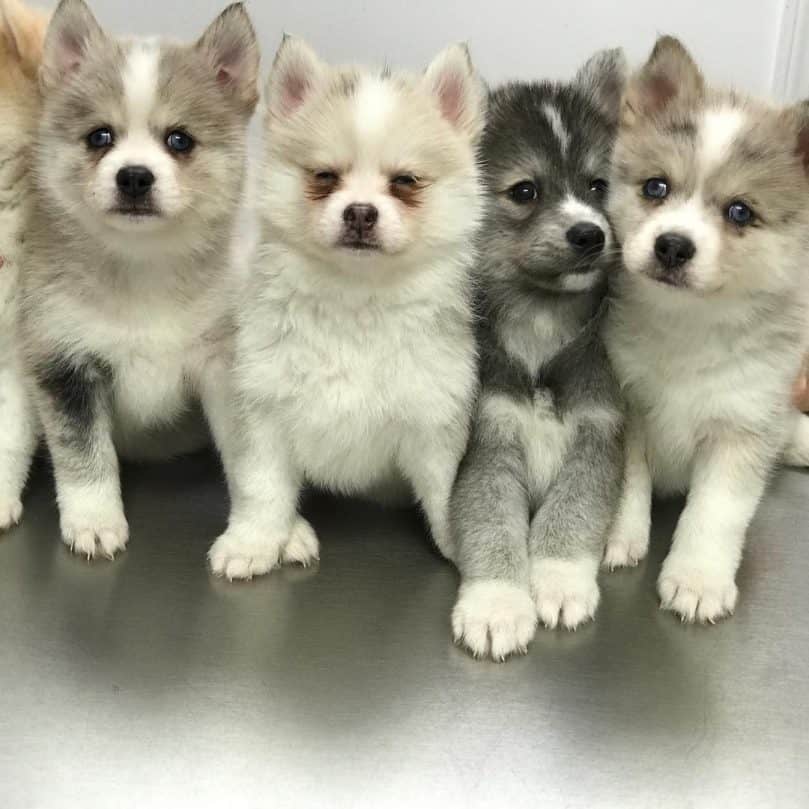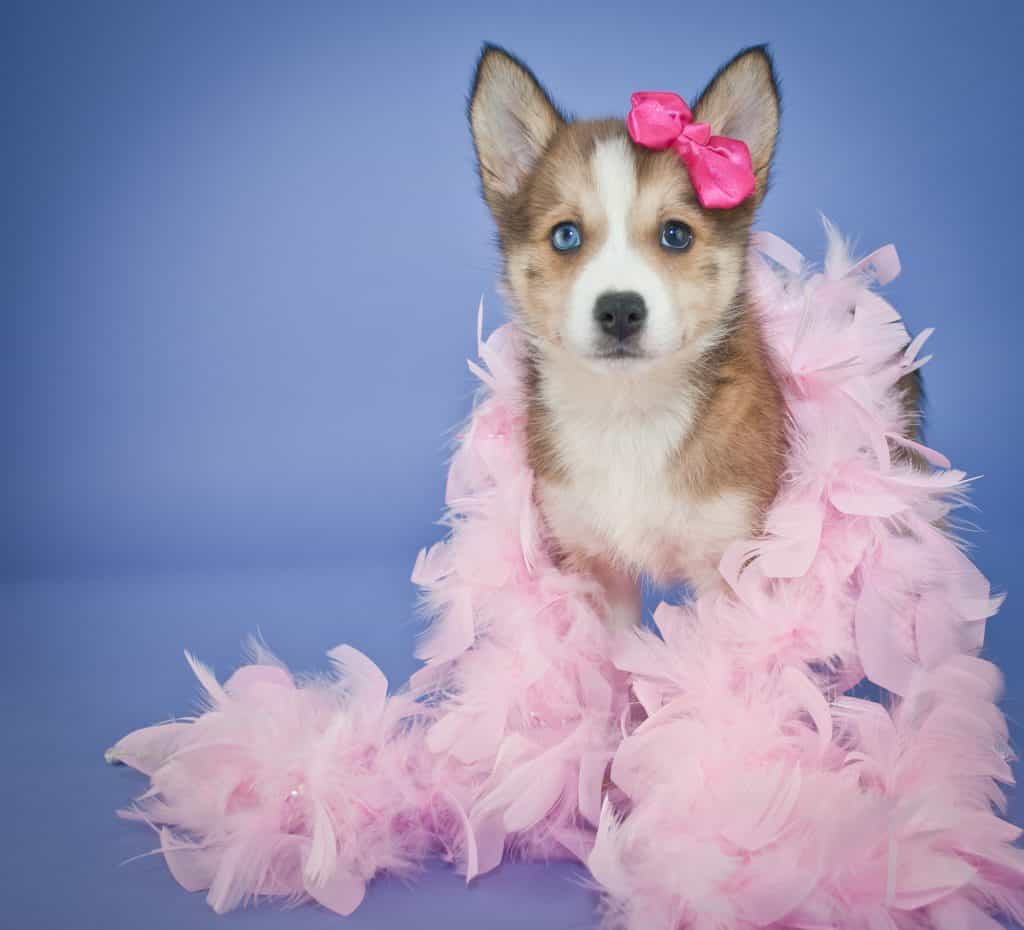This page contains affiliate links. We may earn money or products from the companies mentioned in this post through our independently chosen links, which earn us a commission. Learn More
That warm lick upon your cheek, that wagging tail meant only for you…the unconditional love of a dog is ultimately what has earned them the crown honor of being man’s best friend.
To own a cute breed of dog like the Pomsky sends the heart ablaze. With its plush little wolfish face, it’s true that this designer dog is steadily capturing hearts and climbing popularity charts.
It’s got the “awww” worthy looks. But, what about its temperament and behavior?
As a new crossbreed, there isn’t much knowledge to go off of when determining a recurring behavior pattern that is specific to the Pomsky. There are ways to try and prepare for what can be expected though.
In this post, we’ll help you navigate the personality of the Pomsky, setting the cute factor aside for a more in-depth look at its genetic makeup.
Contents & Quick Navigation
Let’s Talk About Dog Temperament Basics

image source courtesy of @dr.alanobara
We are going back to basics firstly, and that begins with understanding the art of dog breeds.
I’m sure you’ve heard of a dog being either a purebred or a crossbreed. There are a few main differences between the two that warrants certain attributions when it comes to physical looks and personality traits.
This is what you need to understand.
Purebred dogs are well documented
Dogs that are considered to be purebred have a historical advantage. They have been selectively bred the same way with same breed parents for decades or even centuries to carefully preserve bloodlines.
This produces offspring that exhibit only the best genes specific to that particular breed.
Therefore, purebred dogs are known to display typical behaviors and temperaments that they have been specially bred to have.
For example, Rottweilers were bred to be guard dogs, so they are known to be protective, loyal and aggressive.
Designer dog breed
Crossbreeds are a wonderful melting pot of all sorts of genes that produce a mixed dog breed. The only catch is, no one can know how a hybrid will turn out when it comes to looks, temperament, and behavior.
Coming from parents of two different breeds, there are a wide variety of characteristics that play into the genetic makeup of the pup. No two hybrid puppies are the same!
So, if a breeder tries to guarantee their litter of Pomsky puppies will definitely behave a certain way, sport Husky markings or grow to be an exact size, call them out on that bologna. There’s just no way to know for sure with a hybrid dog.
Now, Let’s Go Back to the Pomsky’s Roots
To get somewhat of an idea of the type of behavioral traits to expect with a Pomsky, it all starts with the parents.
The Siberian Husky and Pomeranian are well known purebred dogs with distinguishable temperaments. These traits shine through in their Pomsky offspring, but of course, it won’t be an exact match.
Also, when you’re looking to buy a Pomsky, remember to ask breeders about the parents’ background. This will help give you a more streamlined insight into the health and temperament of a specific litter.
Siberian Husky Temperament

This breed has been a favorite for years. It’s gorgeous looks, high intelligence and playful nature make it an excellent family dog. It’s known to get along well with adults and children alike.
The Husky is a pack dog, requiring an owner that will exert leadership. Without someone to stimulate them mentally and physically with training and daily exercise, it can be a destructive breed with chewing tantrums that’ll make you clutch your leather designer purse in fear.
Regardless, training whips this high functioning breed into shape, resulting in a loyal and loving canine companion for life.
Pomeranian Temperament
These small-sized dogs have a reputation for being extra yappy with bundles of energy to boot.
A possessive nature makes the Pomeranian prone to developing small dog syndrome. This has a lot to do with the influence of the owner though, and the time invested in training and socialization.
The Pomeranian is also a highly intelligent breed, seeking stimulation, attention and loving affection. This means daily exercise is a must, as well as plenty of cuddles to keep her happy.
What Does This Gene Combo Mean for the Pomsky?
It’s difficult to predict, but the Pomsky’s temperament is generally known to be friendly and loyal.
They seek attention and need plenty of stimulation in order to keep them from becoming destructive and biting up your personal belongings.
As well, Pomskies can turn possessive or exhibit small dog syndrome like the Pomeranian, but this behavior can be curbed by training and exercise.
We mentioned that Pomeranians can be noisy, and with the Husky being more on the quiet side, it can go either way for the Pomsky. Alas, it depends on the genetic makeup.
Let’s break it down in more detail, shall we?
1.Top characteristics to know about Pomsky Temperament
- Intelligent
- High energy
- Extroverted
- Loving
2. Behavior traits to watch out for
- Possessive
- If left alone for long periods of time can be destructive
- Small Dog Syndrome
3. Trainability tips that benefit the Pomsky
- Start training at an early age to curb behavioral problems in the future
- Focus on plenty of socialization to combat possessiveness
- Needs plenty of exercises to burn energy, such as walks or playing with toys
Pomskies Make Wonderful Family Dogs
If you’re worried about whether or not a Pomsky will be the right fit for your children or other pets, let us put those worries to rest.
With their loving dispositions, eagerness to please and devout loyalty- Pomskies are a joy. They’re always ready to lay down lots of love and are looking for plenty of attention from their family members.
Keep in mind that Pomskies can be possessive of toys or food around other pets. When playing around children, their high energy exertion can be dangerous (if the children are toddler age). This can be handled with proper training, walks, and exercise, as well as socialization.
Conclusion: There’s One Big Rule of Thumb to Remember

Ultimately, you can’t predict what a Pomsky’s temperament and behavior will be. Every puppy is different, and as a crossbreed, the genetic makeup is varied and unique.
You can compare the Pomeranian and Siberian Husky parents to get clues, but honestly, nothing is guaranteed. If a breeder tries to tell you otherwise- consider their guarantee a red flag.
Like any dog breed, training is highly beneficial in shaping temperament. This is true for the Pomsky, who comes from a background of highly intelligent parents that are loyal, energetic and playful.
Both the Husky and Pomeranian are known to be wonderful family dogs with excellent traits, so it’s safe to say that the Pomsky has some excellent genes to inherit.
It’s up to you as the owner to keep an open mind and be ready to work with your Pomsky to shape obedience.
If you are interested in learning more about the Pomsky breed as a whole, read our informative guide here.
More information on Pomskies:
This was a part 3 in a 5-part series that details everything you need to know about the Pomsky.
Check out our entire series here:


Leave a Reply